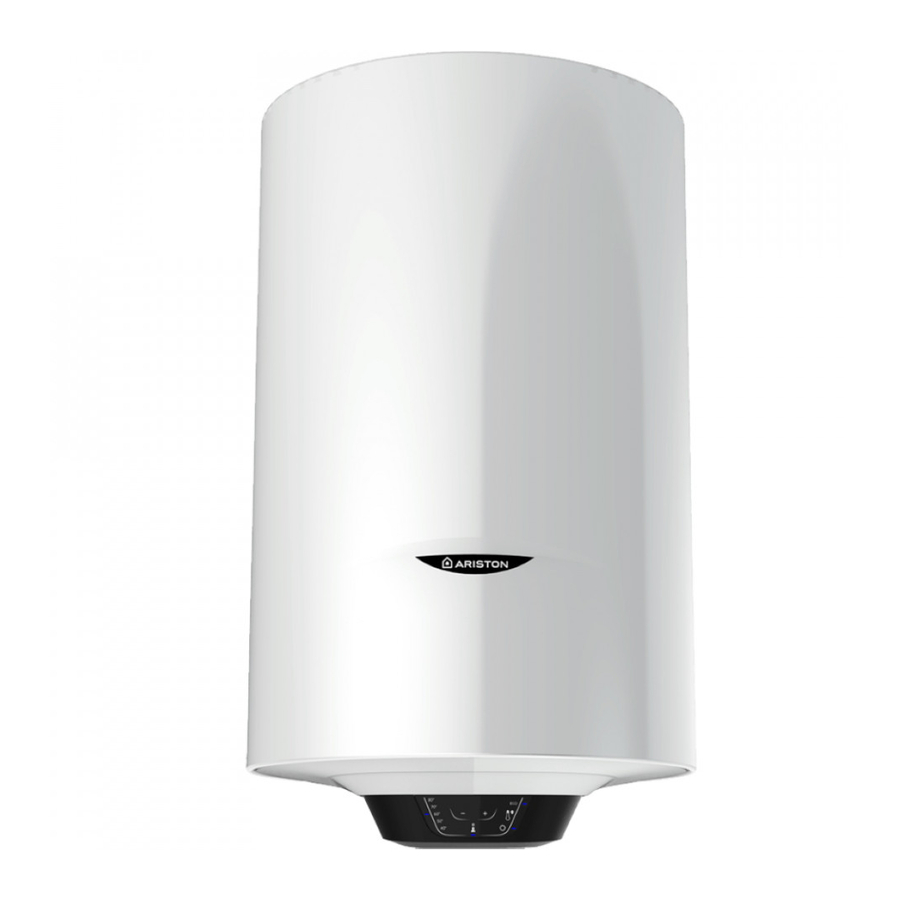Ariston PRO1 ECO Series Manual - Halaman 9
Jelajahi secara online atau unduh pdf Manual untuk Pemanas Air Ariston PRO1 ECO Series. Ariston PRO1 ECO Series 19 halaman. Unvented

straight pipe 9 m long.
i.e. Discharge pipes between 9 m and 18 m equivalent resistance length should be at
least 2 sizes larger than the nominal outlet size of the safety
m and 27 m at least 3 times larger, and so on.
cated with the cylinder. The tundish must also be in a position visible to the occupants, and positioned away from
Bends must be taken into account in calculating the flow resistance.
any electrical devices. The discharge pipe from the tundish should terminate in a safe place where there is no risk to
See fig..5 and Table 2.
persons in the vicinity of the discharge and to be of metal.
2) Discharge pipes from the temperature & pressure relief and pressure relief valve may be joined together.
4) The discharge pipe must have a vertical section of pipe at least 300 mm in length,
below the tundish before any elbows or bends in the pipe work.
3) The pipe diameter must be at least one pipe size larger than the nominal outlet size of the safety device unless its
total equivalent hydraulic resistance exceeds that of a straight pipe 9 m long.
i.e. Discharge pipes between 9 m and 18 m equivalent resistance length should be at least 2 sizes larger than the
5) The discharge pipe must be installed with a continuous fall.
nominal outlet size of the safety device. Between 18 m and 27 m at least 3 times larger, and so on.
Bends must be taken into account in calculating the flow resistance. See fig.1 and Table 2.
6) The discharge must be visible at both the tundish and the final point of discharge,
but where this is not possible or practically difficult; there should be clear visibility at
4) The discharge pipe must have a vertical section of pipe at least 300 mm in length, below the tundish before any
elbows or bends in the pipe work.
one or other of these locations. Examples of acceptance are:
i) Ideally below a fixed grating and above the water seal in a trapped gully.
5) The discharge pipe must be installed with a continuous fall.
ii) Downward discharges at a low level; i.e. up to 100 mm above external surfaces
6) The discharge must be visible at both the tundish and the final point of discharge, but where this is not possible or
such as car parks, hard standings, grassed areas etc. These are acceptable providing
practically difficult; there should be clear visibility at one or other of these locations. Examples of acceptance are:
that where children may play or otherwise come into contact with discharges, a wire
i) Ideally below a fixed grating and above the water seal in a trapped gully.
cage or similar guard is positioned to prevent contact, whilst maintaining visibility.
ii) Downward discharges at a low level; i.e. up to 100 mm above external surfaces such as car parks, hard standings,
grassed areas etc. These are acceptable providing that where children may play or otherwise come into contact with
iii) Discharges at high level; i.e. into a metal hopper and metal down pipe with
discharges, a wire cage or similar guard is positioned to prevent contact, whilst maintaining visibility.
end of the discharge pipe clearly visible (tundish visible or not). Or onto a roof capable
iii) Discharges at high level; i.e. into a metal hopper and metal down pipe with the end of the discharge pipe clearly vis-
ible (tundish visible or not). Or onto a roof capable of withstanding high temperature discharges of water 3 m from
any plastic guttering systems that would collect such a discharge (tundish visible).
Fig.. 4
Suggest ways of terminating discharge pipes safely
Temperature & pressure
relief valve
iv) Where a single pipe serves a number of discharges, such as in blocks of flats, the number served should be limited to
no more than 6 systems so that any installation can be traced reasonably easily. The single common discharge pipe
should be at least one pipe size large than the largest individual discharge pipe to be connected. If unvented hot
water storage systems are installed where discharges from safety devices may not be apparent i.e. in dwellings oc-
cupied by the blind, infirm or disabled people, consideration should be given to the installation of an electronically
Metal discharge pipe (D1) from
temperature & pressure relief valve.
to tundish.
600 mm Max.
300 mm
Min.
Metal discharge pipe (D2) from tundish
with continuous fall. See Table 2 and worked
example.
Tundish
device. Between 18
Discharge below
fixed grating.
(see page 6 for
alternative points
of discharge).
Fixed grating
Trapped gulley
the
15
